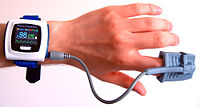
Photo from wikipedia
Rationale Breathing is a cyclic activity that is variable by nature. Breathing variability is modified in mechanically ventilated patients. We aimed to evaluate whether decreased variability on the day of… Click to show full abstract
Rationale Breathing is a cyclic activity that is variable by nature. Breathing variability is modified in mechanically ventilated patients. We aimed to evaluate whether decreased variability on the day of transition from assist-control ventilation to a partial mode of assistance was associated with a poorer outcome. Methods This was an ancillary study of a multicentre, randomised, controlled trial comparing neurally adjusted ventilatory assist to pressure support ventilation. Flow and the electrical activity of the diaphragm (EAdi) were recorded within 48 h of switching from controlled ventilation to a partial mode of ventilatory assistance. Variability of flow and EAdi-related variables were quantified by the coefficient of variation, the amplitude ratio of the spectrum's first harmonic to its zero-frequency component (H1/DC) and two surrogates of complexity. Main results 98 patients ventilated for a median duration of 5 days were included. H1/DC of inspiratory flow and EAdi were lower in survivors than in nonsurvivors, suggesting a higher breathing variability in this population (for flow, 37% versus 45%, p=0.041; for EAdi, 42% versus 52%, p=0.002). By multivariate analysis, H1/DC of inspiratory EAdi was independently associated with day-28 mortality (OR 1.10, p=0.002). H1/DC of inspiratory EAdi was lower in patients with a duration of mechanical ventilation <8 days (41% versus 45%, p=0.022). Noise limit and the largest Lyapunov exponent suggested a lower complexity in patients with a duration of mechanical ventilation <8 days. Conclusion Higher breathing variability and lower complexity are associated with higher survival and lower duration of mechanical ventilation.
Journal Title: ERJ Open Research
Year Published: 2023
Link to full text (if available)
Share on Social Media: Sign Up to like & get
recommendations!